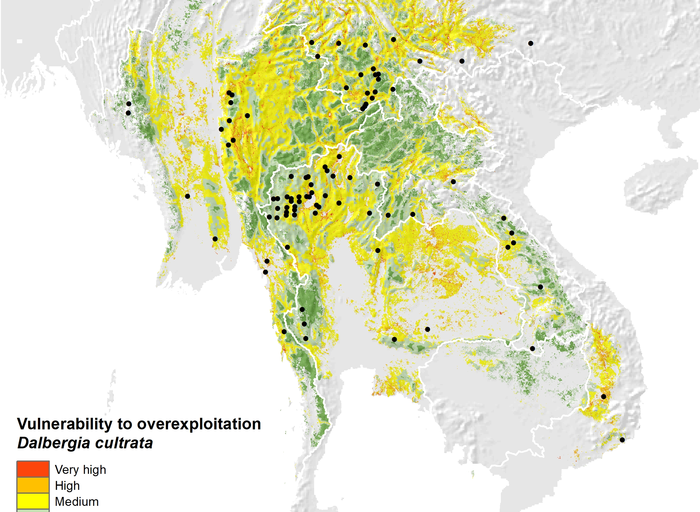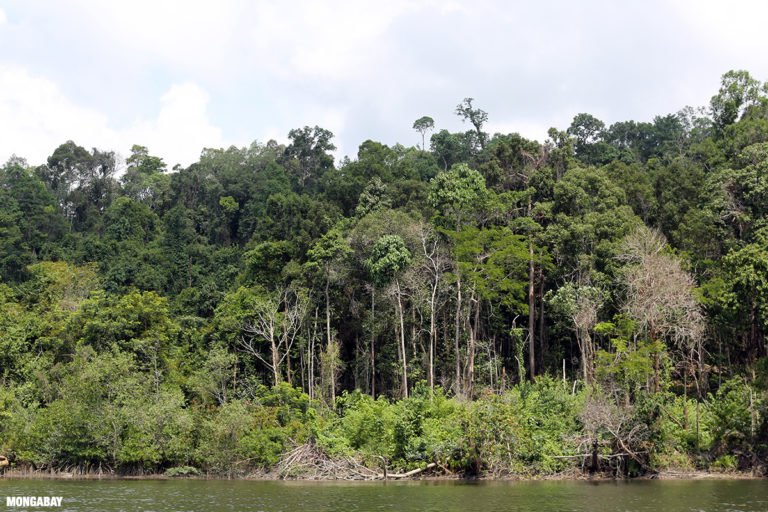- Rosewood is one of the world’s most trafficked wildlife products: The value of the trade, driven by demand from luxury furniture markets, exceeds that of ivory.
- Despite increased legal protections and export bans in recent years, illegal logging and cross-border trade continues to decimate rosewood populations across Asia, Africa and Latin America.
- A new study reveals the threats facing isolated and fragmented populations of three rosewood species in the Greater Mekong region and identifies where conservation and restoration action could have the most benefits.
- The study recommends a variety of approaches to protect the viability of remaining natural populations and their genetic diversity, including community forestry, smallholder planting initiatives, agroforestry, and storing seeds in gene banks.
Rosewood trees are a mainstay of tropical forests across parts of Asia, Africa and Latin America. But their future looks bleak. Their fragrant, red-hued heartwood is prized by makers of luxury furniture, and illegal loggers and timber trafficking networks are systematically obliterating rosewoods from forest landscapes the world over to feed this demand.
Halting the illegal rosewood trade, which mainly supplies markets in China, is tricky: it’s a big business. The value of the illegal international trade in rosewood timber exceeds that of ivory, according to a 2020 report from the U.N. Office on Drugs and Crime.
To stem the destruction, in 2016 the entire genus of Dalbergia — a large group that includes all rosewood species — was added to Appendix II of the Convention on International Trade in Endangered Species of Wild Fauna and Flora (CITES), making it an offense to trade the species internationally without a permit.
But despite the increased protections, trees are still cut down and illegally traded due to legislative loopholes and limited enforcement. Moreover, scientists and conservationists know very little about the isolated and fragmented rosewood populations that remain.
To address this knowledge gap, an international team of scientists recently used a combination of species distribution data, spatial analysis and local expert knowledge to gauge where rosewood populations persist in the Greater Mekong region, a global hub of the rosewood trade. They also assessed the trees’ vulnerability to a suite of threats and identified priority areas where action would prove most effective.
The study focused on three species: Siamese rosewood (Dalbergia cochinchinensis), Burmese blackwood (Dalbergia cultrata) and Burmese rosewood (Dalbergia oliveri), which the team deemed to be most in need of research to support conservation and sustainable use, Riina Jalonen, co-author of the study and a scientist at the Alliance of Bioversity International and CIAT, told Mongabay. According to the IUCN Red List, the species are considered vulnerable, near threatened and endangered, respectively.
The findings, published in Biological Conservation, indicate that all three species face significant risks to their survival across 75% of their native range. Unsurprisingly, the analysis showed that overexploitation is the severest threat facing the remaining populations, followed by habitat loss and fire.
“The message is pretty clear … overexploitation is a real problem,” Edward Webb, professor of global forests at the University of Helsinki, who was not involved in the study, told Mongabay. He said tackling illegal logging of rosewoods will require closing the legislative loopholes that traffickers exploit and that enable them to pass off illegally harvested timber as plantation derived, thereby qualifying them for a CITES trade permit.
“It comes down to the capacity of the government, the forest departments, and actually the willingness to restrict the movement of natural timber and not allow it to be mixed in with plantation timber,” Webb said.
He noted that overexploitation of natural populations remains a problem despite many countries having export bans in place for a number of rosewood species. This indicates that timber is likely still being cut and traded within countries, he said.

The study indicates that up to one-fifth of rosewood populations are located within protected areas. However, the authors say this doesn’t guarantee their future. Illegal logging is well documented within protected areas in the Greater Mekong countries, and even populations within well-managed protected areas are subject to the inescapable effects of climate change. As part of their analysis, the research team looked at how climate change is likely to affect key rosewood habitats across the region, finding that Burmese blackwood will be most affected, impacted across at least 20% of its range.
Outside of protected areas, the researchers found that rosewood populations face still greater threats. One solution to curb illegal logging could be investing in community forestry, whereby forest-dependent people are supported to patrol and protect forests. In Cambodia, community forests support some of the country’s largest remaining populations of Siamese rosewood and Burmese blackwood, according to the study.
“Community forests harbour some of the last remaining populations of rosewoods across the Greater Mekong region,” Jalonen said. “These forests are crucially important as genetic reserves and seed sources for species recovery. Yet they are also severely threatened by illegal logging … Community forestry groups need financial and technical support to carry out this work.”
The study also highlighted specific areas where conservation and restoration action could prove most effective for rosewoods, and made recommendations for governments and organizations to work together to coordinate strategies to safeguard them.
Several landscapes stood out as areas that could particularly benefit from cross-border collaboration, Jalonen said, such as the subtropical forests spanning parts of China, Laos, Myanmar, Thailand and Vietnam, and the moist deciduous forests along the border between Laos and Thailand. She added that collaborative action was particularly urgent because few rosewood populations present in these areas are within protected areas, and there’s little suitable land for other conservation measures.
“Countries need to join forces to safeguard the species’ remaining genetic diversity in these ecoregions,” Jalonen said, “and to produce and share genetically diverse [seeds] for restoration, [because] few viable populations likely remain in each individual country.”

Genetic diversity is a key consideration for the isolated and fragmented populations, especially in the face of climate change. Safeguarding the wild trees across as wide a range of environmental conditions as possible will help to preserve adaptive traits that might enable the trees to cope with future climate change impacts.
However, the study notes that it might be necessary to supplement natural populations with planted specimens in severely depleted areas to preserve species genetic diversity. And where planting isn’t an option, the researchers advise collection and storage of seeds in gene banks. To this end, some countries have initiated rosewood planting programs via smallholder seed orchards and agroforestry systems.
“The value of planting rosewoods has already been realised in Cambodia, where Siamese rosewood has become the most planted native tree species with well over one million seedlings planted each year,” Jalonen said. “We hope that the trend also picks up in other countries in the region. Supply of timber from plantations could help reduce pressure on the remaining natural populations … although this would take quite some time.”
So Thea, co-author of the study and a researcher at Cambodia’s Forest Research Institute, said the popularity of Siamese rosewood planting is likely due to a number of factors, including the reputation of its high-value timber and the ease with which it can be cultivated. “Being a legume it fixes atmospheric nitrogen through a symbiosis with nitrogen-fixing bacteria,” he said. “This ability allows it to grow on a variety of soils, and to be planted in reforestation, home gardens or agroforestry, and urban areas.”
Webb said he fully supports planting rosewoods to boost the viability of natural populations and to prevent local extinctions. However, he cautioned that planting should not be seen as a substitute for protecting remaining wild populations by cracking down on timber trafficking through strengthened enforcement and accountability. “You have to protect the native populations, you just have to,” he said, “otherwise they will keep getting illegally logged and illegally traded.”
Banner image: The Dalbergia genus belongs to the legume family; many rosewoods have colourful sprays of flowers like this Dalbergia lanceolaria photographed in India. Image by Dinesh Valke via Creative Commons (CC BY-SA 2.0)
Citation:
Gaisberger, H., Fremout, T., So, T., Thammavong, B., Bounithiphonh, C., Hoa, T. T., … Jalonen, R. (2022). Range-wide priority setting for the conservation and restoration of Asian rosewood species accounting for multiple threats and ecogeographic diversity. Biological Conservation, 270, 109560. doi:10.1016/j.biocon.2022.109560
Carolyn Cowan is a staff writer for Mongabay. Follow her on Twitter @CarolynCowan11
FEEDBACK: Use this form to send a message to the author of this post. If you want to post a public comment, you can do that at the bottom of the page.













